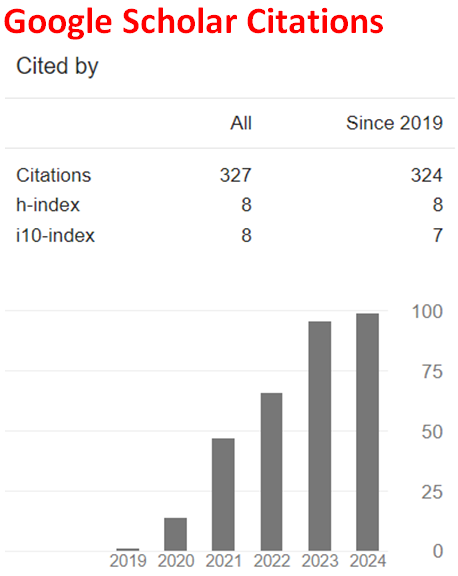Some Isomers of DNNC and Radicals from Them - A DFT Treatment
Abstract
In the present density functional study, some isomers of 1,3,5,5-tetranitrohexahydropyrimidine (DNNC) have been considered within the constraints of the theory and the basis set employed (UB3LYP/6-31++G(d,p)). Various geometrical, QASR and quantum chemical properties are harvested and discussed. All the considered isomers of DNNC have exothermic heat of formation and favorable Gibbs free energy of formation values at the standard states and they are stable electronically. Based on the interfrontier molecular orbital energy gap values DNNC is found to be more sensitive to impulse stimulus than the others. Also radicals obtained from DNNC isomers considered (by the homolytic rapture of C-NO2 or N-NO2 bonds) have been focus of present interest. The radicals obtained by the cleavage of geminal C-NO2 bonds have exothermic Hº and favorable Gº values at the standard states and electronically stable as their respective parent compounds. Although, some of the radicals generated by the homolytic cleavage of N-NO2 bonds are thermo chemically exothermic and stable, like the radicals mentioned above, the radicals from the isomer having all the nitro groups in vicinal configuration decomposes by eliminating one of the geminal nitro groups.
Downloads
References
Boileau, J., Piteau, M., & Jacob, G. (1990). Short communication – notice. Synthèse de la 1,3,5,5-tetranitrohexahydropyrimidine. Propellants Explos. Pyrotech., 15(1), 38-38. https://doi.org/10.1002/prep.19900150111
Agrawal, J.P. (2010). High energy materials, Weinheim: Wiley-VCH. https://doi.org/10.1002/9783527628803
Yang, K., Bi, F., Xue, Q., Huo, H., Bai, C., Zhang, J., & Wang, B. (2021). Synthesis and properties of azamonocyclic energetic materials with geminal explosophores. Dalton Trans. 50(24), 8338-8348. PMID: 34042918. https://doi.org/10.1039/d1dt00581b
Dorothy, A.C., & Horst, G.A. (1982). Nitrolysis of dialkyl tert-butylamines. J. Org. Chem., 47(12), 2474-2476. https://doi.org/10.1021/jo00133a047
Sinditskii, V.P., Smirnova, A.D., Vu, T.Q., Filatov, S.A., Serushkin, V.V., & Rudakov, G.F. (2020). Thermal decomposition of 1,3,5,5-tetranitrohexahydropyrimidine: a new type of autocatalysis that persists at high temperatures. Propellants Explos. Pyrotech., 45, 1-10. https://doi.org/10.1002/prep.202000259
Li, Y., Xia, H., Song, S., Wang, K., & Zhang, Q. (2023). One-step synthesis of 6-amino-5-nitro-2-(trinitromethyl)-pyrimidin-4(3H)-one as potential energetic material. Inorganic Chemistry Communications, 152, 110673.
Levins, D.L., Bedford, C.D., & Coon, C.L. (1982). 1,3,5,5-tetranitrohexahydropyrimidine (DNNC). U.S. Patent 4,346,222 (1982), SRI International, USA (24 Aug. 1982), SRI International, Menlo Park, California, US.
Shackelford, S.A., & Goldman, J.F. (1995). Heat of fusion for 1,3,5,5- tetranitrohexahydropyrimidine (DNNC) and its DNNC-d6 deuterium labeled analogue. Propellants Explos. Pyrotech., 20(1), 1-4. https://doi.org/10.1002/prep.19950200102
Oyumi, Y., Brill, T.B., Rheingold, A.L., & Haller, T.M. (1985). Crystal structure and molecular dynamics of the energetic nitramine 1,3,5,5-tetranitrohexahydropyrimidine and a comparison with 1,3,3,5,7,7-hexanitro-1,5-diazacyclooctane and 1,3,3-trinitroazetidine. J. Phys. Chem., 89, 4317-4324. https://doi.org/10.1021/j100266a033
Shackelford, S.A., & Goldman, J.F. (1992). Intramolecular mechanistic thermochemical decomposition studies of 1,3,5,5-tetranitrohexahydropyrimidine (DNNC) and its deuterium labeled analogues [Abstract]. Presented at the 203rd National American Chemical Society Meeting, San Francisco, CA, April 5-10. American Chemical Society.
Shackelford, S.A., Menapace, J.A., & Goldman, J.F. (2007). Liquid state thermochemical decomposition of neat 1,3,5,5-tetranitrohexahydropyrimidine (DNNC) and its DNNC-d2, DNNC-d4, DNNC-d6 structural isotopomers: Mechanistic entrance into the DNNC molecule. Thermochimica Acta, 464(1-2), 42-58. https://doi.org/10.1016/j.tca.2007.08.005
Hendrickson, S.A., & Shackelford, S.A. (2006). Solid state thermochemical decomposition of neat 1,3,5,5-tetranitrohexahydropyrimidine (DNNC) and its DNNC-d6 perdeuterio-labeled analogue. Thermochimica Acta, 440(2), 146-155. https://doi.org/10.1016/j.tca.2005.11.007
Roos, B.D., & Brill, T.B. (2003). Thermal decomposition of energetic materials 84: pyrolysis of 5-substituted 1,3,5-trinitrohexahydropyrimidines. Propellants Explos. Pyrotech., 28(2), 65-71. https://doi.org/10.1002/prep.200390010
Stewart, J.J.P. (1989). Optimization of parameters for semi empirical methods I. Journal of Computational Chemistry, 10, 209-220. https://doi.org/10.1002/jcc.540100208
Stewart, J.J.P. (1989). Optimization of parameters for semi empirical methods II. Journal of Computational Chemistry, 10, 221-264. https://doi.org/10.1002/jcc.540100209
Leach, A.R. (1997). Molecular modeling. Longman.
Kohn, W., & Sham, L.J. (1965). Self-consistent equations including exchange and correlation effects. Physical Review, 140, A1133-A1138. https://doi.org/10.1103/PhysRev.140.A1133
Parr, R.G., & Yang, W. (1989). Density functional theory of atoms and molecules. Oxford University Press.
Becke, A.D. (1988). Density-functional exchange-energy approximation with correct asymptotic behavior. Physical Review A, 38, 3098-3100. https://doi.org/10.1103/PhysRevA.38.3098
Vosko, S.H., Wilk, L., & Nusair, M. (1980). Accurate spin-dependent electron liquid correlation energies for local spin density calculations: a critical analysis. Canadian Journal of Physics, 58, 1200-1211. https://doi.org/10.1139/p80-159
Lee, C., Yang, W., & Parr, R.G. (1988). Development of the Colle-Salvetti correlation energy formula into a functional of the electron density. Physical Review B, 37, 785-789. https://doi.org/10.1103/PhysRevB.37.785
SPARTAN 06 (2006). Wavefunction Inc. Irvine CA, USA.
Anbu, V., Vijayalakshmi, K.A., Karunathan, R., Stephen, A.D., & Nidhin, P.V. (2019). Explosives properties of high energetic trinitrophenyl nitramide molecules: A DFT and AIM analysis. Arab. J. Chem., 12(5) 621-632. https://doi.org/10.1016/j.arabjc.2016.09.023
Badders, N.R., Wei, C., Aldeeb, A.A., Rogers, W.J., & Mannan, M.S. (2006). Predicting the impact sensitivities of polynitro compounds using quantum chemical descriptors. J. Energ. Mater., 24, 17-33. https://doi.org/10.1080/07370650500374326
Politzer, P., & Murray, J.S. (1996). Relationships between dissociation energies and electrostatic potentials of C-NO2 bonds: applications to impact sensitivities. Journal of Molecular Structure, 376(1-3), 419-424. https://doi.org/10.1016/0022-2860(95)09066-5
Song, X., Cheng, X., Yang, X., Li, D., & Linghu, R. (2008). Correlation between the bond dissociation energies and impact sensitivities in nitramine and polynitro benzoate molecules with polynitro alkyl groupings. Journal of Hazardous Materials, 150(2), 317-321. https://doi.org/10.1016/j.jhazmat.2007.04.105
Türker, L. (2005). Structure-impact sensitivity relation of some substituted 1,3,5-trinitrobenzenes. Journal of Molecular Structure (THEOCHEM), 725(1-3), 85-87. https://doi.org/10.1016/j.theochem.2005.01.040
Zeman, S. (2002). Modified Evans–Polanyi–Semenov relationship in the study of chemical micromechanism governing detonation initiation of individual energetic materials. Thermochimica Acta, 384(1-2), 137-154. https://doi.org/10.1016/S0040-6031(01)007870
Rice, B.M., Sahu, S., & Owens, F.J. (2002). Density functional calculations of bond dissociation energies for NO2 scission in some nitroaromatic molecules. Journal of Molecular Structure: THEOCHEM, 583(1-3), 69-72. https://doi.org/10.1016/S0166-1280(01)00782-5
Tan, B., Long, X., & Li, J. (2012). The cage strain energies of high-energy compounds. Computational and Theoretical Chemistry, 993, 66-72. https://doi.org/10.1016/j.comptc.2012.05.033
Song, Q., Zhang, L., & Mo, Z. (2022). Alleviating the stabilityperformance contradiction of cage-like high-energy-density materials by a backbone-collapse and branch-heterolysis competition mechanism. Phys. Chem. Chem. Phys., 24, 19252-19262. https://doi.org/10.1039/D2CP02061K

This work is licensed under a Creative Commons Attribution 4.0 International License.


